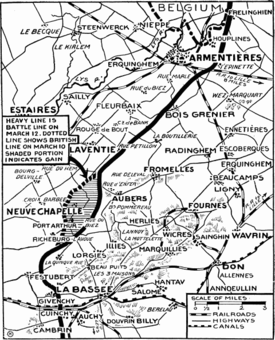| Battle of Festubert | |||||||
|---|---|---|---|---|---|---|---|
| Part of the Second Battle of Artois on the Western Front of World War I | |||||||
Front line following the Battle of Neuve Chapelle, (10–13 March 1915) | |||||||
| |||||||
| Belligerents | |||||||
|
• • • |
| ||||||
| Commanders and leaders | |||||||
|
|
| ||||||
| Strength | |||||||
| 6 Divisions | 3 Divisions | ||||||
| Casualties and losses | |||||||
|
|
| ||||||
The Battle of Festubert (15–25 May 1915) was an attack by the British army in the Artois region of France on the western front during World War I.
Context[]
It was part of the larger French Artois Offensive and was undertaken to assist the French near Arras by preventing German reserve troops from being available to move there.[1]
The battle[]
The attack was made by the British First Army under Sir Douglas Haig against a German salient between Neuve Chapelle to the north and the village of Festubert to the south. The assault was planned along a 3-mile (4.8 km) front and would initially be made mainly by Indian troops. This would be the first British army night attack of the war.[2]
The battle was preceded by a 60 hour bombardment by 433 artillery pieces that fired about 100,000 shells.[3] This bombardment failed to significantly damage the front line defences of the German Sixth Army, but the initial advance made some progress in good weather conditions.[4] The attack was renewed on the 16th, and by the 19th the British 2nd and 7th divisions had to be withdrawn due to heavy losses.[5]
On 18 May the Canadian Division, assisted by the 51st (Highland) Division, renewed the advance, but this made little progress in the face of effective German artillery fire. The British forces then entrenched themselves at the new front line in conditions of heavy rain. The Germans now brought up more reserves to reinforce their lines.[6]
From 20–25 May the attack was renewed, resulting in the capture of the village of Festubert. However the total offensive had only resulted in a 1-kilometre (0.62 mi) advance, at a cost of 16,648 casualties.[7] The Canadian Division's part in the offensive gained them 900 metres (980 yd) on a 1.6-kilometre (0.99 mi) front and cost 2,107 casualties.[7]
See also[]
Footnotes[]
- ↑ Farndale 1986, p. 107.
- ↑ Edmonds 1928, pp. 49–52.
- ↑ Edmonds 1928, pp. 52–55.
- ↑ Edmonds 1928, pp. 56–58.
- ↑ Edmonds 1928, pp. 59–73.
- ↑ Edmonds 1928, pp. 73–77.
- ↑ 7.0 7.1 Edmonds 1928, p. 76.
References[]
- Edmonds, J. (1928). History of the Great War Based on Official Documents By Direction of the Historical Section of the Committee of Imperial Defence: Military Operations France and Belgium, 1915: Battles of Aubers Ridge, Festubert, and Loos (1st ed.). London: Macmillan. OCLC 58962526.
- Farndale, M. (1986). History of the Royal Regiment of Artillery, Western Front 1914–18. London: Royal Artillery Institution. ISBN 1-870114-00-0.
- Christie, N (2007). For King and Empire: Vol. IX. Other Canadian Battlefields, 1915–1917. Ottawa: CEF Books. ISBN 1-89697-919-X.
External links[]
The original article can be found at Battle of Festubert and the edit history here.
